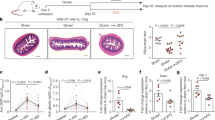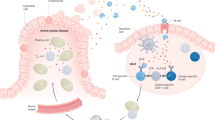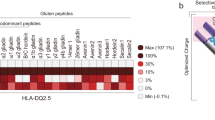Abstract
The action of tissue Transglutaminase1 (TGase) on specific protein-bound glutamine residues plays a critical role in numerous biological processes2–5. Here we provide evidence for a new role of this enzyme in the common, HLA-DQ2 (and DQ8) associated6 enteropathy, celiac disease (CD). The intestinal inflammation in CD is precipitated by exposure to wheat gliadin in the diet7 and is associated with increased mucosal activity of TGase8. This enzyme has also been identified as the main _target for CD-associated anti-endomysium autoantibodies9, and is known to accept gliadin as one of its few substrates10. We have examined the possibility that TCase could be involved in modulating the reactivity of gliadin specific T cells. This could establish a link between previous reports of the role of TCase in CD and the prevailing view of CD as a T-cell mediated disorder7,11,12. We found a specific effect of TGase on T-cell recognition of gliadin. This effect was limited to gliadin-specific T cells isolated from intestinal CD lesions. We demonstrate that TGase mediates its effect through an ordered and specific deamidation of gliadins. This deamidation creates an epitope that binds efficiently to DQ2 and is recognized by gut-derived T cells. Generation of epitopes by enzymatic modification is a new mechanism that may be relevant for breaking of tolerance and initiation of autoimmune disease.
This is a preview of subscription content, access via your institution
Access options
Subscribe to this journal
Receive 12 print issues and online access
We are sorry, but there is no personal subscription option available for your country.
Buy this article
- Purchase on SpringerLink
- Instant access to full article PDF
Prices may be subject to local taxes which are calculated during checkout
Similar content being viewed by others
References
Folk, J.E. Mechanism and basis for specificity of transglutaminase-catalyzed ɛ-(γ-glutamyl) lysine bond formation. Adv. Enzymol. Relat. Areas Mol. Biol. 54, 1–56 (1983).
Kahlem, P., Terre, C., Green, H. & Djian, P. Peptides containing glutamine repeats as substrates for transglutaminase-catalyzed cross-linking: relevance to diseases of the nervous system Proc. Natl. Acad. Sci. USA 93, 14580–14585 (1996).
Aeschlimann, D. & Paulsson, M. Transglutaminases: protein cross-linking enzymes in tissues and body fluids. Thromb. Haemost. 71, 402–415 (1994).
Davies, P.J. et al. Transglutaminase is essential in receptor-mediated endocytosis of α2-macroglobulin and polypeptide hormones. Nature 283, 162–167 (1980).
Teshigawara, K., Kannagi, R., Noro, N. & Masuda, T. Possible involvement of transglutaminase in endocytosis and antigen presentation. Microbiol. Immunol. 29, 737–750 (1985).
Sollid, L.M. & Thorsby, E. HLA susceptibility genes in celiac disease: genetic mapping and role in pathogenesis. Gastroenterology 105, 910–922 (1993).
Trier, J.S. Celiac sprue. N. Engl. J. Med. 325, 1709–1719 (1991).
Bruce, S.E., Bjarnason, I. & Peters, T.J. Human jejunal transglutaminase: demonstration of activity, enzyme kinetics and substrate specificity with special relation to gliadin and coeliac disease. Clin. Sci. (Colch.) 68, 573–579 (1985).
Dieterich, W. et al. Identification of tissue transglutaminase as the autoantigen of celiac disease. Nature Med. 3, 797–801 (7–1997).
Larre, C. et al. Gliadin modifications catalysed by guinea pig liver transglutaminase. J. Food. Biochem 267–282 (1993).
Lundin, K.E.A. et al. Cliadin-specific, HLA-DQ(α1*0501,β1*0201) restricted T cells isolated from the small intestinal mucosa of celiac disease patients. J. Exp. Med. 178, 187–196 (1993).
MacDonald, T.T. In Coeliac Disease (ed. Marsh, M. N.) 283–304 (Blackwell Scientific, Oxford, 1992).
Frazer, A.C. Gluten-induced enteropathy, the effect of partially digested gluten. Lancet 252–255 (1959).
Wieser, H. In Coeliac disease (ed. Howdle, P. D.) 191–208 (Bailliere Tindall, London, 1995).
Watts, C. Capture and processing of exogenous antigens for presentation on MHC molecules. Ann. Rev. Immunol. 15, 821–850 (1997).
Gjertsen, H.A. et al. T cells from the peripheral blood of coeliac disease patients recognize gluten antigens when presented by HLA-DR, -DQ, or -DP molecules. Scand. J. Immunol. 39, 567–574 (1994).
Hamada, J.S. Deamidation of food proteins to improve functionality. Crit. Rev. Food Sci. Nutr. 34, 283–292 (1994).
Johansen, B.H. et al. Identification of a putative motif for binding of peptides to HLA-DQ2. Int. Immunol. 8, 177–182 (1996).
van de Wal, Y. et al. Peptide binding characteristics of the coeliac disease-associated DQ(α1*0501, β1*0201) molecule. Immunogenetics 44, 246–253 (1996).
Halstensen, T.S. et al. In situ two- and three-color immunofluorescence staining of mucosal T-cells in celiac disease. Increase of TCR γ/δ+CD8- and TCR α/β+CD45RO+ intraepithelial lymphocytes and IL2R+ TCR α/β+CD4+CD45RO+lamina propria lymphocytes. Prog. Histochem. Cytochem. 26, 201–210 (1992).
Sollid, L.M., Molberg, O., McAdam, S. & Lundin, K.E.A. Autoantibodies in coeliac disease,. Tissue transglutaminase - guilty by association. Gut 41, 851–852 (1997).
Kwok, W.W. et al. HLA-DQB1 codon 57 is critical for peptide binding and recognition. J. Exp. Med. 183, 1253–1258 (1996).
Meadows, L. et al. The HLA-A*0201-restricted H-Y antigen contains a posttranslationally modified cysteine that significantly affects T cell recognition. Immunity 6, 273–281 (1997).
Skipper, J.C. et al. An HLA-A2-restricted tyrosinase antigen on melanoma cells results from posttranslational modification and suggests a novel pathway for processing of membrane proteins. J. Exp. Med. 183, 527–534 (1996).
Michaelsson, E. et al. T cell recognition of carbohydrates on type II collagen. J. Exp. Med. 180, 745–749 (1994).
Molberg, Ø. et al. CD4+ T cells with specific reactivity against astrovirus isolated from normal human small intestine. Gastroenterology 114, 115–122 (1998).
Lundin, K.E.A. et al. T cells from the small intestinal mucosa of a DR4, DQ7/DR4, DQ8 celiac disease patient preferentially recognize gliadin when presented by DQ8. Hum. Immunol. 41, 285–291 (1994).
Kouskoff, V., Signorelli, K., Benoist, C. & Mathis, D. Cassette vectors directing expression of T cell receptor genes in transgenic mice. J. Immunol. Methods 180, 273–280 (1995).
Letourneur, F. & Malissen, B. Derivation of a T cell hybridoma variant deprived of functional T cell receptor α/β chain transcripts reveals a nonfunctional alpha-mRNA of BW5147 origin. Eur. J. Immunol. 19, 2269–2274 (1989).
Hunt, D.F. et al. Protein sequencing by tandem mass spectrometry. Proc. Natl. Acad. Sci. USA 83, 6233–6237 (1986).
Karas, M. & Hillenkamp, F. Laser desorption ionization of proteins with molecular masses exceeding 10,000 daltons. Anal. Chem. 60, 2299–2301 (1988).
Fenn, J.B. et al. Electrospray ionization for mass spectrometry of large biomolecules. Science 246, 64–71 (1989).
Cooks, G.L., Glish, G.L., McLuskey, S.A. & Kaiser, R.E. Ion trap mass spectrometry. Chem. Eng. News 25, 26–41 (1991).
Author information
Authors and Affiliations
Rights and permissions
About this article
Cite this article
Molberg, Ø., Mcadam, S., Körner, R. et al. Tissue transglutaminase selectively modifies gliadin peptides that are recognized by gut-derived T cells in celiac disease. Nat Med 4, 713–717 (1998). https://doi.org/10.1038/nm0698-713
Received:
Accepted:
Issue Date:
DOI: https://doi.org/10.1038/nm0698-713



